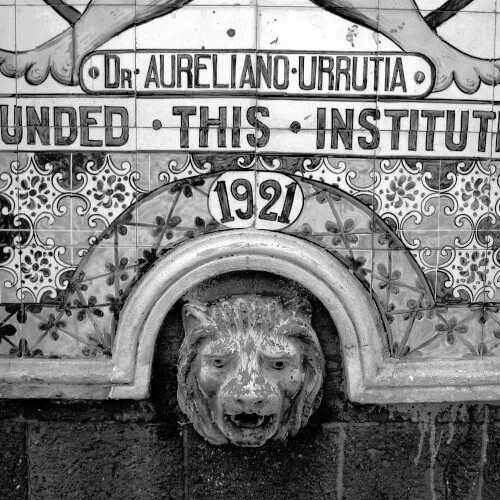Miraflores Gets a New Next-Door Neighbor
Recently, I scrolled through the San Antonio Report, my favorite local news source, and discovered an article about Incarnate Word moving into the old “AT&T building.” The university, a longtime neighbor across Hildebrand, will now directly share its backyard property line with Miraflores, the early-to-mid twentieth century riverside garden created by my great grandfather, Dr. Aureliano Urrutia.
I’ve been anticipating this news for about a year, aware that every new change in these surrounding urban landscapes can greatly impact the future of neighboring environments. The garden itself, in its nearly 100 year history, excluding the 40 or so years that Urrutia cultivated it, has had four other owners, as it struggled to survive, filled with art and its own story.
Miraflores’ past is intimately tied to the adjacent property now belonging to UIW, starting with the doctor’s ownership of both. In fact, the two properties were one—the garden and the new UIW property—until 1953 when USAA purchased the larger portion leaving the octogenarian with the remaining five-acre garden along the river.
USAA commissioned Ayres & Ayres Architects, and Robert Moss Ayres designed the large modernist office building for its headquarters. The company, one of San Antonio’s largest employers, became Miraflores’ first next-door neighbor for another several years before it purchased the garden too.
As an aside, and carrying some weight in my concerns about Miraflores’ future—its new neighbor, UIW, was actually the third owner of the garden from 2000-2005, transferring it to the City of San Antonio fueled by concerns over the disappearing landscape. The garden is now managed under a long term agreement with the Brackenridge Park Conservancy. None of the former three corporate owners of Miraflores—USAA, AT&T, or UIW—were conscientious stewards of the garden by preservationist standards. But then, only recently has Miraflores’ cultural significance come to be considered as an asset which deserves any attention.
Incarnate Word has some shared history with my family, which may have a positive effect on the relationship. Beginning in the 1920’s, Dr. Urrutia and his immediate family of doctors and pharmacists developed a professional and spiritual connection to the Sisters of Charity of the Incarnate Word. They worked together in a common mission of healthcare at the Santa Rosa Hospital and even worshiped together, attending services at Incarnate Word Chapel. In 2019 the Urrutia family was among a number of groups recognized at the Sisters’ 150th anniversary celebration of their healthcare and education ministries.
The university’s purchase will automatically expand the campus with its existing eight story building and thousand parking spaces. Hopefully any future plans for the UIW landscape will be sensitive to the historical significance and needs of its neighbor. Challenges include access to Miraflores, which is already somewhat problematic with regard to maintenance and events, but also environmental concerns such as sunlight patterns and views as restoration of the historic garden becomes more possible. The university, as a good neighbor, could choose a positive treatment to these issues, greatly improving Miraflores’ chances for future success.
According to the San Antonio Report, the new building, Founder’s Hall, will house administrative offices along with the “Institute of the Americas” founded by Liza and Jack Lewis III, whose family is a long time supporter of the university. The story of Miraflores is one that could mesh nicely with UIW’s multi-cultural intentions.
Given their new physical proximity, the question is not whether, but how the future paths of UIW and Miraflores will cross. This is all speculation at this point. But in my imagination, I am cautiously optimistic, contingent upon the idea that the Brackenridge Park Conservancy, as the property’s managing body, will represent Miraflores’ best interest. It could be a small intersection such as working out a neighborly access plan for maintenance or larger groups visiting the garden, to a grander approach involving some level of collaboration toward the authentic restoration of Miraflores. Ultimately, Miraflores might even become an avenue for UIW’s Institute of the Americas’ mission to promote greater understanding among countries of the Americas.
Miraflores is, after all, San Antonio’s Mexican Garden of Memory.
Anne Elise Urrutia’s book, Miraflores: San Antonio’s Mexican Garden of Memory, is forthcoming this fall (2021) from Trinity University Press.
Historical photo from the Urrutia collection, all rights reserved.
Posted on December 9, 2020. Updated July 2021.








